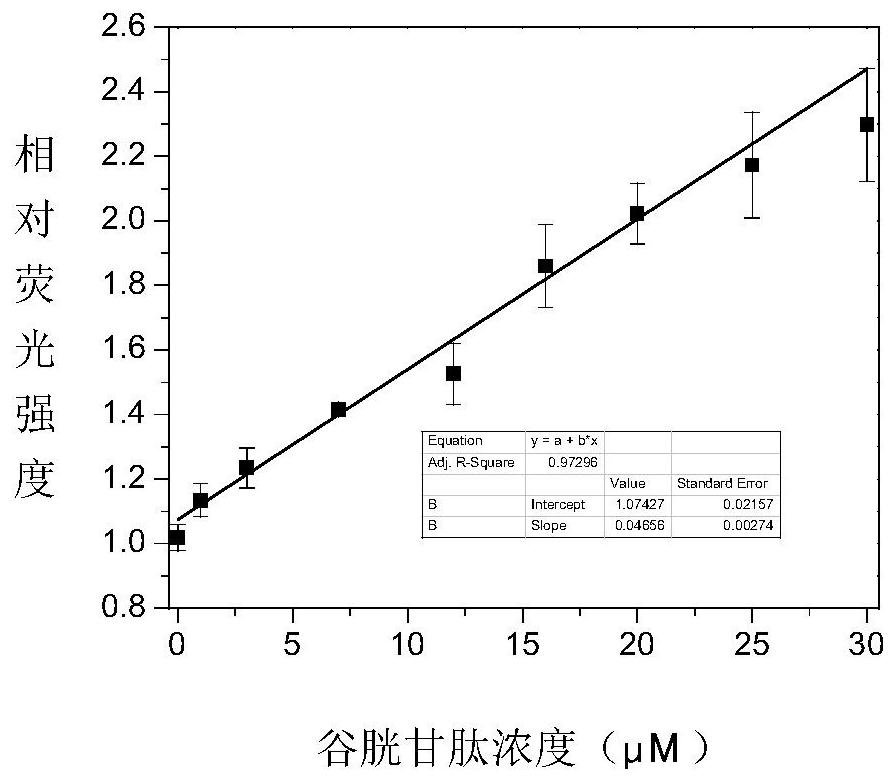A method for the detection of sulfhydryl biomolecules based on dual-emission fluorescence detection of doped ZnS nanocrystal probes
A dual emission fluorescence, biomolecular technology, applied in the field of chemical measurement, can solve the problem of being easily interfered by external environmental factors, and achieve the effect of convenient and fast method, simple operation, and avoidance of interference.
- Summary
- Abstract
- Description
- Claims
- Application Information
AI Technical Summary
Problems solved by technology
Method used
Image
Examples
Embodiment 1
[0026] 1) Preparation of Cu-doped ZnS nanocrystals
[0027] Disperse 878 mg of zinc acetate dihydrate, 10 mg of copper sulfate pentahydrate and 87 μL of mercaptopropionic acid in 200 mL of ultrapure water to form a solution, and stir evenly. Then the sodium hydroxide solution adjusted the pH value of the solution to 9 to obtain the precursor solution. A microwave reaction tube was used to take 15 mL of the precursor solution and place it in a microwave reactor, set the reaction temperature to 120°C, and stop the experiment after the reaction was carried out for about 50 minutes, and the Cu-doped ZnS nanocrystal solution was obtained. Cu-doped ZnS nanocrystals with dual emission bands can be obtained by centrifugal washing, the appearance is shown in figure 1 , keep away from light for later use.
[0028] 2) Modulation of double emission fluorescence of doped nanocrystals
[0029] Take an appropriate amount of Cu-doped ZnS nanocrystals and disperse them in water, then add bi...
Embodiment 2
[0033] 1) Preparation of Co-doped ZnS nanocrystals
[0034] Disperse 878 mg of zinc acetate dihydrate, 12 mg of cobalt sulfate pentahydrate and 87 μL of mercaptopropionic acid in 180 mL of ultrapure water to form a solution, and stir evenly. Then the sodium hydroxide solution adjusted the pH value of the solution to 9 to obtain the precursor solution. Take 20mL of the precursor solution in a microwave reaction tube and place it in a microwave reactor, set the reaction temperature at 120°C, and stop the experiment after the reaction is carried out for about 60 minutes, and the Co-doped ZnS nanocrystal solution is obtained. Co-doped ZnS nanocrystals with double emission bands can be obtained by centrifuging and washing, and stored in the dark for future use.
[0035] 2) Modulation of double emission fluorescence of doped nanocrystals
[0036] An appropriate amount of Co-doped ZnS nanocrystals was dispersed in water, and then bicyclohexanone oxalyldihydrazone was added successi...
PUM
 Login to View More
Login to View More Abstract
Description
Claims
Application Information
 Login to View More
Login to View More - R&D
- Intellectual Property
- Life Sciences
- Materials
- Tech Scout
- Unparalleled Data Quality
- Higher Quality Content
- 60% Fewer Hallucinations
Browse by: Latest US Patents, China's latest patents, Technical Efficacy Thesaurus, Application Domain, Technology Topic, Popular Technical Reports.
© 2025 PatSnap. All rights reserved.Legal|Privacy policy|Modern Slavery Act Transparency Statement|Sitemap|About US| Contact US: help@patsnap.com



